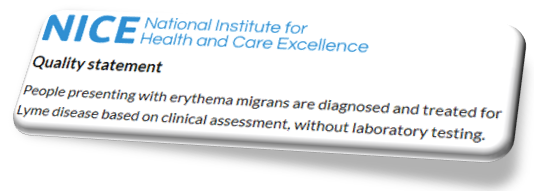A recent study has highlighted that patient care within the NHS is not streamlined. It is, in fact a lottery. Even in areas where Lyme disease is acknowledged to have a higher incidence, GPs seem unaware of NICE guideline recommendations.
On one day this month, we had 2 contrasting emails which illustrates this perfectly.
Case 1 – How to get care right
In the North of England (lower incidence of Lyme disease). A walker bitten by something unseen on her arm, developed a rash. It had a clear erythema migrans appearance, although small and slightly warm – so it could have been a straightforward infected insect bite. Although the patient had no other symptoms , the GP had no hesitation in providing 21 days doxycycline as recommended by NICE. The rash is disappearing and this person has developed no further symptoms. This is how it should be.
Case 2 – How to fail the patient
In the South – higher incidence. Also bitten on the arm, but definitely by a tick. A bull’s eye rash developed and the GP provided 7 days of antibiotics. 4 weeks later, this patient was becoming quite ill with painful joints, dizzy spells, nausea and complete exhaustion. Seeing the photos of the rash (and the lingering rash on the arm) the GP referred for a blood test, which came back negative. The lab pointed out this might be false negative, so the GP will try another one next week. Meanwhile, what will happen to this patient?
Perhaps every GP should have one of these on their desk during this peak time of Lyme disease diagnosis.
 The NICE Quality Standards are there to help healthcare providers and commissioners to improve the quality of care for Lyme disease patients. They are measurable and achievable. Providers will in due course measure how they are managing to achieve these standards.
The NICE Quality Standards are there to help healthcare providers and commissioners to improve the quality of care for Lyme disease patients. They are measurable and achievable. Providers will in due course measure how they are managing to achieve these standards.
Treating EM when it is visible, without wasting NHS money and patients’ time (and lives) really is a no-brainer.
Perhaps the labs could help improve patient care by adding to their standard text “If an EM is present, or clinical suspicion is high, then treat”. That would save the cost of further testing and help ensure the patient has a better chance of complete recovery.
UPDATE 23 August 2019
The Case 2 patient took LDA’s email to her GP surgery’s Practice Manager and in a short while a correct prescription was faxed to the local pharmacy to enable treatment to start immediately.

 Printer Friendly
Printer Friendly